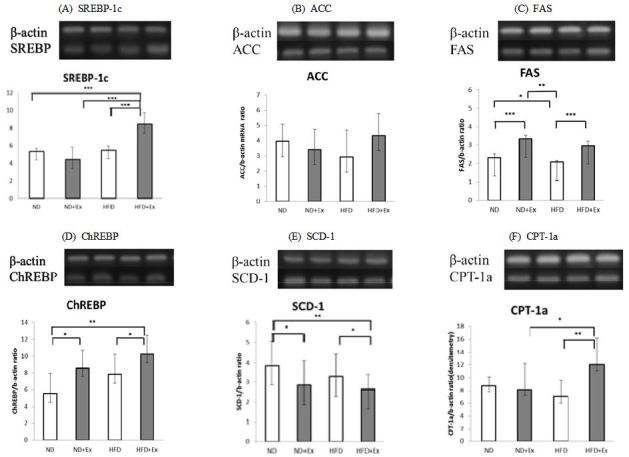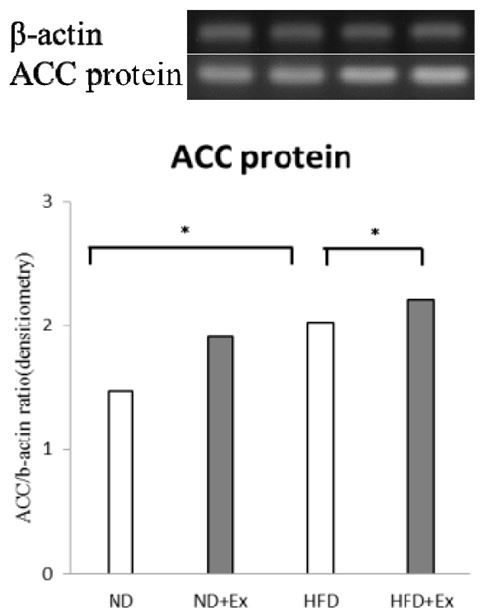1. Storlien LH., Baur LA., Kriketos AD., Pan DA., Cooney GJ., et al Jenkins AB.. Dietary fats and insulin action. Diabetologia 1996;39:621-31. PMID:
10.1007/BF00418533. PMID:
8781757.



2. Surwit RS., Kuhn CM., Cochrane C., McCubbin JA., Feinglos MN.. Diet induced type II diabetes in C57BL/6J mice. Diabetes 1988;37:1163-7. PMID:
10.2337/diab.37.9.1163. PMID:
3044882.


3. Powers SK., Criswell D., Lawler J., Martin D., Lieu FK., et al Ji LL.. Rigorous exercise training increases superoxide dismutase activity in ventricular myocardium. Am J Physiol 1993;265:H2094-8. PMID:
8285249.


4. Huang W., Dedousis N., Bandi A., Lopaschuk GD., O’Doherty RM.. Liver triglyceride secretion and lipid oxidative metabolism are rapidly altered by leptin in vivo. Endocrinology 2005;147(3):1480-7. PMID:
10.1210/en.2005-0731. PMID:
16339207.



5. Yoshikawa H., Tajiri Y., Sako Y., Hashimoto F., Umeda F., Nawata H.. Effects of biotin on glucotoxicity or lipotoxicity in rat pancreatic islets. Metabolism 2002;51(2):163-8. PMID:
10.1053/meta.2002.29979. PMID:
11833042.


6. Yang JY., Lee SJ., Park HW., Cha YS.. Effect of genistein with carnitine administration on lipid parameters and obesity in C57Bl/6J mice fed a high-fat diet. J Med Food 2006;9(4):459-67. PMID:
10.1089/jmf.2006.9.459. PMID:
17201630.


7. Dobrzyn P., Pyrkowska A., Jazurek M., Szymanski K., Langfort J., Dobrzyn A.. Endurance training-induced accumulation of muscle triglycerides is coupled to upregulation of stearoyl-CoA desaturase 1. J Appl Physiol 2010;109(6):1653-61. PMID:
10.1152/japplphysiol.00598.2010. PMID:
20847127.


8. Charbonneau A., Melancon A., Lavoie C., Lavoie J-M.. Alterations in hepatic glucagons receptor density and in alterations in Gsα and Giα2 protein content with diet-induced hepatic steatosis: effects of acute exercise. Am J Physiol Endocrinol Metab 2005;289:E8-14. PMID:
10.1152/ajpendo.00570.2004. PMID:
15687107.


9. Lavoie J-M., Yasari S., Abdennadher M., Paquette A.. Effects of alternations (10days) of high-fat with normal diet on liver lipid infiltration, fat gain, and plasma metabolic profile in rats. Physiol Behav 2005;86:442-8. PMID:
10.1016/j.physbeh.2005.07.018. PMID:
16154606.


10. Gregoire FM., Zhang Q., Smith SJ., Tong C., Ross D., et al Lopez H.. Diet-induced obesity and hepatic gene expression alternations in C57BL/6J and ICAM-1-deficient mice. Am J Physio Endocrinol Metab 2002;282:E703-13. PMID:
10.1152/ajpendo.00072.2001.

11. Fatehi-Hassanabad Z., Chan CB.. Transcriptional regulation of lipid metabolism by fatty acids: a key determinant of pancreatic β-cell function. Nutr Metab 2005;2(1):1-12. PMID:
10.1186/1743-7075-2-1.

12. Dentin R., Girard J., Postic C.. Carbohydrate responsive element binding protein (ChREBP) and sterol regulatory element binding protein-1c (SREBP-1c): two key regulators of glucose metabolism and lipid synthesis in liver. Biochimie 2005;87:81-6. PMID:
10.1016/j.biochi.2004.11.008. PMID:
15733741.


13. Iizuka K., Bruick RK., Liang G., Horton JD., Uyeda K.. Deficiency of carbohydrate response element-binding protein (ChREBP) reduces lipogenesis as well as glycolysis. Proc Natl Acad Sci 2004;101(19):7281-6. PMID:
10.1073/pnas.0401516101. PMID:
15118080.



14. Terblanche SE., Gohil K., Packer L., Henderson S., Brooks GA.. The effects of endurance training and exhaustive exercise on mitochondrial enzymes in tissues of the rat (Rattus norvegicus). Comp Biochem Physiol A Mol Integr Physiol 2001;128(4):889-96. PMID:
10.1016/S1095-6433(00)00344-5. PMID:
11282330.


16. Reeves PG., Nielsen FH., Fahey GC. Jr. AIN-93 purified diets for laboratory rodents: final report of the American Institute of Nutrition ad hoc writing committee on the reformulation of the AIN-76A rodent diet. J Nutr 1993;123(11):1939-51. PMID:
8229312.



17. Eunhee C., Gary MD.. Moderate intensity, but not high intensity, treadmill exercise training alters power output properties in myocardium from aged rats. J Gerontol A Biol Sci Med Sci 2012;67(11):1178-87. PMID:
10.1093/gerona/gls146. PMID:
22843668.




18. Brooks GA., White TP.. Determination of metabolic and heart rate responses of rats to treadmill exercise. J Appl Physiol 1978;45(6):1009-15. PMID:
730582.


19. Friedewald WT., Levy RI., Fredrickson DS.. Estimation of the concentration of low-density lipoprotein cholesterol in plasma, without use of the preparative ultracentrifuge. Clin Chem 1972;18:499-502. PMID:
4337382.



20. Noma A., Okabe H., Kita M.. A new colorimetric micro- determination of free fatty acids in serum. Clin Chim Acta 1973;43(3):317-20. PMID:
10.1016/0009-8981(73)90468-3. PMID:
4690904.


21. Straczkowski M., Kowalska I., Dzienis-Straczkowska S., Kinalski M., Gorski J., Kinalska I.. The effect of exercise training on glucose tolerance and skeletal muscle triacylglycerol content in rats fed with a high fat diet. Diabetes Metab 2001;27(1):29-23.
22. Drouin R., Robert G., Milot M., Massicotte D., Peronnet F., Lavoie C.. Swim training increases glucose output from liver perfused in situ with glucagon in fed and fasted rats. Metabolism 2004;53(8):1027-31. PMID:
10.1016/j.metabol.2004.03.010. PMID:
15281013.


23. Ozaki H., Yasuda T., Ogasawara R., Sakamaki-Sunaga M., Naito H., Abe T.. Effects of high-intensity and blood flow-restricted low-intensity resistance training on carotid arterial compliance: role of blood pressure during training sessions. Eur J Appl Physiol 2013;113(1):167-74. PMID:
10.1007/s00421-012-2422-9. PMID:
22618304.



24. Ghanassia E., Brun JF., Mercier J., Raynaud E.. Oxidative mechanisms at rest and during exercise. Clinica Chimica Acta 2007;383:1-20. PMID:
10.1016/j.cca.2007.04.006.

25. Hu C., Hoene M., Zhao X., Häring HU., Schleicher E., et al Lehmann R.. Lipidomics analysis reveals efficient storage of hepatic triacylglycerides enriched in unsaturated fatty acids after one bout of exercise in mice. PLoS One 2010;5(10):e133318. PMID:
10.1371/journal.pone.0013318.

26. Marques CM., Motta VF., Torres TS., Aguila MB., Mandarim-de-Lacerda CA.. Beneficial effects of exercise training (treadmill) on insulin resistance and nonalcoholic fatty liver disease in high-fat fed C57BL/6 mice. Braz J Med Biol Res 2010;43(5):467-75. PMID:
10.1590/S0100-879X2010007500030. PMID:
20490434.



27. Horton JD., Goldstein JL., Brown MS.. SREBPs: activators of thecomplete program of cholesterol and fatty acid synthesis in the liver. J Clin Invest 2002;109:1125-31. PMID:
10.1172/JCI0215593. PMID:
11994399.



28. Kakuma T., Lee Y., Higa M., Wang Z., Pan W., et al Shimomura I.. Leptin, troglitazone, and the expression of sterol regulatoryelement binding proteins in liver and pancreatic islets. Proc Natl Acad Sci 2000;97:8536-41. PMID:
10.1073/pnas.97.15.8536. PMID:
10900012.



29. Kim S., Sohn I., Lee Y., Lee Y.. Hepatic gene expression profiles are altered by genistein supplementation in mice with diet-induced obesity. J Nutr 2005;33-41. PMID:
15623829.



30. Sakurai TS., Takei M., Ogasawara J., Ueda H., Kizaki T., et al Ohno H.. Exercise before or after refeeding prevents refeeding-induced recovery of cell size faster fasting with a different pattern of metabolic gene expressions in rat epididymal adipocytes. Metabolism 2007;56:1270-78. PMID:
10.1016/j.metabol.2007.05.014. PMID:
17697872.


31. Dentin R., Pegorier JP., Benhamed F., Foufelle F., Ferre P., et al Fauveau V.. Hepatic glucokinase is required for the synergistic action of ChREBP and SREBP-1c on glucolytic and lipogenic gene expression. J Biol Chem 2004;279(19):20314-26. PMID:
10.1074/jbc.M312475200. PMID:
14985368.


32. Lizuka K., Bruick RK., Liang G., Horton JD., Uyeda K.. Deficiency of carbohydrate response element-binding protein (ChREBP) reduces lipogenesis as well as glycolysis. Proc Natl Acad Sci 2004;101(19):7281-6. PMID:
10.1073/pnas.0401516101. PMID:
15118080.



33. Yamashita H., Takenoshita M., Sakurai M., Bruick RK., Henzel WJ., et al Shillinglaw W.. A glucose-responsive transcription factor that regulates carbohydrate metabolism in the liver. Proc Natl Acad Sci 2002;98:9116-21. PMID:
10.1073/pnas.161284298. PMID:
11470916.

34. Benhamed F., Denechaud PD., Lemoine M., Robichon C., Moldes M., et al Bertrand-Michel J.. The lipogenic transcription factor ChREBP dissociates hepatic steatosis from insulin resistance in mice and humans. J Clin Invest 2012;122(6):2176-94. PMID:
10.1172/JCI41636. PMID:
22546860.



35. Yasari S., Prud'homme D., Wang D., Jankowski M., Levy E., et al Gutkowska J.. Exercise training decreases hepatic SCD-1 gene expression and protein content in rats. Mol Cell Biochem 2010;335(1-2):291-9. PMID:
10.1007/s11010-009-0279-y. PMID:
19777326.



36. Griffiths MA., Baker DH., Novakofski JE., Ji LL.. Effects of exercise training on diet-induced lipogenic enzymes and body composition in rats. J Am Coll Nutr 1993;12(2):155-61. PMID:
10.1080/07315724.1993.10718296. PMID:
8096529.


37. Miyazaki Y., Mahankali A., Wajcberg E., Bajaj M., Mandarino LJ., DeFronzo RA.. Effect of pioglitazone on circulating adipocytokine levels and insulin sensitivity in type 2 diabetic patients. J Clin Endocrinol Metab 2004;89(9):4312-9. PMID:
10.1210/jc.2004-0190. PMID:
15356026.


38. Hildebrandt AL., Neufer PD.. Exercise attenuates the fasting-induced transcriptional activation of metabolic genes in skeletal muscle. Am J Physiol Endocrinol Metab 2000;278(6):E1078-86. PMID:
10827011.












